International Journal of Intelligent Systems and Applications @ijisa
Статьи журнала - International Journal of Intelligent Systems and Applications
Все статьи: 1203
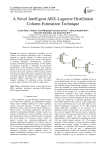
A novel intelligent ARX-Laguerre distillation column estimation technique
Статья научная
In practical applications, modeling of real systems with unknown parameters such as distillation columns are typically complex. To address issues with distillation column estimation, the system is identified by a proposed intelligent, auto-regressive, exogenous-Laguerre (AI-ARX-Laguerre) technique. In this method, an intelligent technique is introduced for data-driven identification of the distillation column. The Laguerre method is used for the removal of input/output noise and decreases the system complexity. The fuzzy logic method is proposed to reduce the system’s estimation error and to accurately optimize the ARX-Laguerre parameters. The proposed method outperforms the ARX and ARX-Laguerre technique by achieving average estimation accuracy improvements of 16% and 9%, respectively.
Бесплатно
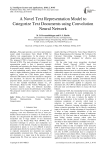
A novel text representation model to categorize text documents using convolution neural network
Статья научная
This paper presents a novel text representation model called Convolution Term Model (CTM) for effective text categorization. In the process of text categorization, representation plays a very primary role. The proposed CTM is based on Convolution Neural Network (CNN). The main advantage of proposed text representation model is that, it preserves semantic relationship and minimizes the feature extraction burden. In proposed model, initially convolution filter is applied on word embedding matrix. Since, the resultant CTM matrix is higher dimension, feature selection methods are applied to reduce the CTM feature space. Further, selected CTM features are fed into classifier to categorize text document. To discover the effectiveness of the proposed model, extensive experimentations are carried out on four standard benchmark datasets viz., 20-NewsGroups, Reuter-21758, Vehicle Wikipedia and 4 University datasets using five different classifiers. Accuracy is used to assess the performance of classifiers. The proposed model shows impressive results with all classifiers.
Бесплатно
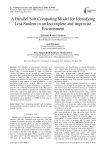
Статья научная
The numbers of educational institutions are growing at par with the lost student rate in a country like India. When a missing student is found we need to identify the student on the strength of some common parameter like student name, his/her institution name, branch or class etc. But we never get accurate and complete information in most of the cases to identify or recognize a lost student. In such a situation, a soft computing model can be a striking choice to track a lost student on the basis of partial information. In the past we propose soft computing model for the same. This paper proposes a more optimized parallel soft computing model which takes half of the time taken by the earlier single thread model for identifying a lost student on the basis of imprecise and partial information. The system is tested meticulously on a database of 50000 records and an efficiency of 94% is obtained.
Бесплатно
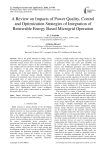
Статья научная
Due to the global demand for energy saving and reduction of greenhouse gas emissions, utilization of renewable energy sources have increased in electricity networks. The negative aspects of this technology are very complex and not well known which affect reliability and robustness of the grids. Microgrids based on renewable energy sources have gained significant popularity, due to the major benefits it has to offer for solving the increasing energy demand. Harmonic distortion in microgrids caused by the non-linear loads is an essential topic of study necessary for the better understanding of power quality impacts in microgrids. The various control techniques utilized to curtail the power quality impacts on micro grids are reviewed in this paper. Also, Optimization based control techniques utilized for power quality improvement in microgrids is discussed in this review.
Бесплатно
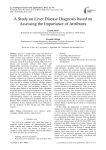
A study on liver disease diagnosis based on assessing the importance of attributes
Статья научная
Liver is a needful body organ that forms an important barrier between the gastrointestinal blood, which contains large amounts of toxins, and antigens. Liver diseases contain hepatitis B and hepatitis C virus infections, alcoholic liver disease, nonalcoholic fatty liver disease and associated cirrhosis, liver failure and hepatocellular carcinoma are primary causes of death. The main purpose of this study is to investigate which attributes are important for effective diagnosis of liver disorders by performing the machine learning approach based on the combination of Stability Selection and Random Forest methods. In order to generate more accuracy, dataset was balanced by utilizing the Random Under-Sampling method. Important ones in all attributes were detected by utilizing the Stability Selection method which was performed on sub-datasets, which were obtained with 5 fold cross-validation technique. By sending these datasets to the Random Forest algorithm, the performance of the proposed approach was evaluated within the frame of accuracy and sensitive metrics. The experimental results clearly show that the Random Under-Sampling method can potentially improve the performance of the combination of Stability Selection and Random Forest methods in machine learning. And, the combination of these methods provides new perspectives for the diagnosis of this disease and other medical diseases.
Бесплатно
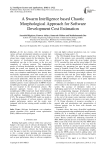
A swarm intelligence based chaotic morphological approach for software development cost estimation
Статья научная
In the last century, with the inception of various software development industries at around mid-1960’s, the complexities and size of the software have always been a major concern for the industries. The ad-hoc process of development has evolved into a standardized one due to the increase in the size and complexity of software projects. The standardized process of software development was further evolved to predict the overall cost required for the development before the software is actually built. To achieve the same, many cost estimation methodologies have already been successfully implemented, each with certain pros and cons. The present scenario demands even further refined and accurate predictions, which the above-said methods cease to provide. In this paper, we present a chaotically modified particle swarm optimization (CMPSO) based morphological learning approach to accurately estimate the cost incurred in the development process. The proposed approach focuses on a mathematical morphological (MM) framework based hybrid artificial neuron (also called dilation-erosion perceptron or DEP) with algebraic foundations in complete lattice theory (CLT). The proposed CMPSO-DEP model was tested on 5 well-known datasets of software projects with three popular performance metrics and the results were compared with the best existing models available in the literature.
Бесплатно
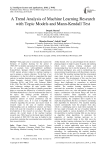
A trend analysis of machine learning research with topic models and Mann-Kendall test
Статья научная
This paper aims to systematically examine the literature of machine learning for the period of 1968~2017 to identify and analyze the research trends. A list of journals from well-established publishers ScienceDirect, Springer, JMLR, IEEE (approximately 23,365 journal articles) related to machine learning is used to prepare a content collection. To the best of our information, it is the first effort to comprehend the trend analysis in machine learning research with topic models: Latent Semantic Analysis (LSA), Latent Dirichlet Allocation (LDA), and LDA with Coherent Model (LDA_CM). The LDA_CM topic model gives the highest topic coherence amongst all topic models under consideration. This study provides a scientific ground that helps to overcome the subjectivity of collective opinion. The Mann-Kendall test is used to understand the trend of the topics. Our findings provide indicative of paradigmatic shifts in research methodology of significant patterns of topical prominence and the evolving research areas. It is used to highlight the evolution regarding the previous and recent trends in research topics in the area of machine learning. Understanding such an intellectual structure and future trends will assist the researchers to adopt the divergent developments of this research in one place. This paper analyzes the overall trends of the machine learning research since 1968, based on the latent topics identified in the period of 2007~2017 that may be helpful to the researchers exploring the recommended areas and publish their research articles.
Бесплатно
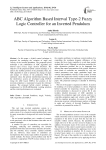
ABC Algorithm Based Interval Type-2 Fuzzy Logic Controller for an Inverted Pendulum
Статья научная
In this paper, a hybrid control technique is proposed for managing the variation of angle and velocity of the inverted pendulum. The proposed hybrid technique is the combination of ABC algorithm and interval type-2 Fuzzy Logic System (IT2FLS). The objective of the proposed hybrid control technique is to achieve the stability position of the pendulum. Here, the ABC algorithm is used to optimize the change of angle and change of velocity of the pendulum. With the optimized value, the optimal membership functions and the interference system are developed using IT2FLS. Using the ABC based IT2FLS, the position of the inverted pendulum is maintained towards the reference position. The proposed hybrid control technique is implemented in MATLAB/Simulink working platform and the control performances are evaluated.
Бесплатно
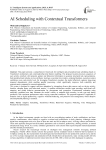
AI Scheduling with Contextual Transformers
Статья научная
This paper presents a comprehensive framework for intelligent and personalized task scheduling based on Transformer architectures and contextual-behavioral feature modeling. The proposed system processes sequences of user activity enriched with temporal, spatial, and behavioral information to generate structured task representations. Each predicted task includes six key attributes: task type, execution time window, estimated duration, execution context, confidence score, and priority level. By leveraging Transformer encoders, the model effectively captures long-range temporal dependencies while enabling parallel processing, which significantly improves both scalability and responsiveness compared to recurrent approaches. The system is designed to support real-time adaptation by integrating diverse data sources such as device activity, location, calendar status, and behavioral metrics. A modular architecture enables input encoding, multi-head self-attention, and global behavior summarization for downstream task generation. Experimental evaluation using artificially generated user data illustrates the model’s ability to maintain high accuracy in task type and timing prediction, with consistent performance under varying contextual conditions. The proposed approach is applicable in domains such as digital productivity, cognitive workload balancing, and proactive time management, where adaptive and interpretable planning is essential.
Бесплатно
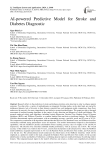
AI-powered Predictive Model for Stroke and Diabetes Diagnostic
Статья научная
Research efforts in the prediction of stroke and diabetes prioritize early detection in order to enhance patient outcomes. To achieve this, a variety of methodologies are integrated. Existing studies, on the other hand, are marred by imbalanced datasets, lack of diversity in their datasets, potential bias, and inadequate model comparisons; these flaws underscore the necessity for more comprehensive and inclusive research methodologies. This paper provides a thorough assessment of machine learning algorithms in the context of early detection and diagnosis of stroke and diabetes. The research employed widely used algorithms, including Logistic Regression, Decision Tree, Random Forest, K-Nearest Neighbors (KNN), and XGBoost Classifier, to examine medical data and derive significant findings. The XGBoost Classifier demonstrated superior performance, with an outstanding accuracy, precision, recall, and F1-score of 87.5%. The comparative examination of the algorithms indicated that the Decision Tree, Random Forest, and XGBoost classifiers consistently exhibited strong performance across all measures. The models demonstrated impressive discrimination capabilities, with the XGBoost Classifier and Random Forest reaching accuracy rates of roughly 87.5% and 86.5% respectively. The Decision Tree Classifier exhibited notable performance, with an accuracy rate of 83%. The overall accuracy of the models was evident in the F1-score, a metric that incorporates recall and precision, where the XGBoost model exhibited a marginal improvement of 2% over the Random Forest and Decision Tree models, and 4.25 percent over the last two. The aforementioned results underscore the effectiveness of the XGBoost Classifier, which will be employed as a predictive model in this study, alongside the Random Forest and Decision Tree models, for the accurate identification of stroke and diabetes. Furthermore, combining datasets improves model performance by utilizing relative features. This integrated dataset improves the model's efficiency and creates a resilient and comprehensive prediction model, improving healthcare outcomes. The findings of this research make a valuable contribution to the advancement of AI-driven diagnostic systems, hence enhancing the quality of healthcare decision-making.
Бесплатно
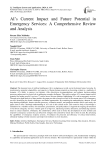
AI’s Current Impact and Future Potential in Emergency Services: A Comprehensive Review and Analysis
Статья научная
The dynamic force of artificial intelligence (AI) is reshaping our world, not in the distant future, but today. Its transformative potential, adaptability, and capacity to liberate human potential are becoming evident in a multitude of domains. AI's ability to process vast datasets, offer data-driven recommendations, and enhance decision-making processes underscores its pivotal role in addressing complex challenges. This article explores AI's current impact and its potential for further growth. It reviews 77 articles across diverse domains, highlighting AI's role in emergency services. Through an in-depth analysis of these studies, the paper provides a broad overview of the current state of AI in emergency services, identifying key trends, challenges, and future opportunities. By examining the methodologies, datasets, AI and deep learning techniques, feature selection processes, evaluation metrics, and prediction models used in each study, the paper aims to offer a thorough understanding of AI's role in this critical sector. This extensive body of knowledge is intended to be a valuable resource for researchers, practitioners, and policymakers. It supports the ongoing advancement of AI-driven emergency services, with the goal of saving lives, optimizing resource allocation, and enhancing response times in critical situations. Ultimately, this collaborative effort seeks to foster the development of more resilient and responsive emergency systems that can effectively mitigate risks and deliver timely aid to those in need. By advancing the capabilities of emergency response systems, AI enhances the precision and efficiency of critical interventions, ultimately leading to better outcomes and improved resilience in crisis situations.
Бесплатно
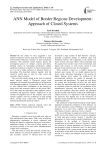
ANN model of border regions development: approach of closed systems
Статья научная
In this article we have suggested a new method of regional systems study that is based on model environmental influences isolation on their parameters dynamics. The presented model deepens greatly the investigation process of complex systems and allows defining clearly its functioning peculiarities without significant reduction in number of system characteristics as if we have simple technical or physical objects of knowledge. The described method, together with the statistical control data, is used for other social and economic objects research. The successful model testing in the form of artificial neural network model of Chernivtsi region static parameters has revealed the peculiarities of its interaction with European neighbors. In particular, for the first time we have defined their contribution to the increase of some social and economic indices on the period 2005-2015, that cannot be explained by other methods, such as correlation and regressive analysis. Applied use of the isolated investigation idea of the complex meso level systems together with the technology of data mining allows solving many actual tasks nominated by the regional administration practical workers.
Бесплатно
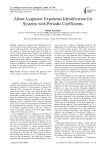
About Lyapunov exponents identification for systems with periodic coefficients
Статья научная
Lyapunov exponents (LE) identification prob-lem of dynamic systems with periodic coefficients is con-sidered under uncertainty. LE identification is based on the analysis of framework special class describing dy-namics of their change. Upper bound for the smallest LE and mobility limit for the large LE are obtained and the indicator set of the system is determined. The graphics criteria based on the analysis of framework special class features are proposed for an adequacy estimation of obtained LE estimations. The histogram method is applied to check for obtained estimation set. We show that the dynamic system can have the LE set.
Бесплатно
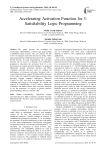
Accelerating Activation Function for 3-Satisfiability Logic Programming
Статья научная
This paper presents the technique for accelerating 3-Satisfiability (3-SAT) logic programming in Hopfield neural network. The core impetus for this work is to integrate activation function for doing 3-SAT logic programming in Hopfield neural network as a single hybrid network. In logic programming, the activation function can be used as a dynamic post optimization paradigm to transform the activation level of a unit (neuron) into an output signal. In this paper, we proposed Hyperbolic tangent activation function and Elliot symmetric activation function. Next, we compare the performance of proposed activation functions with a conventional function, namely McCulloch-Pitts function. In this study, we evaluate the performances between these functions through computer simulations. Microsoft Visual C++ 2013 was used as a platform for training, validating and testing of the network. We restrict our analysis to 3-Satisfiability (3-SAT) clauses. Moreover, evaluations are made between these activation functions to see the robustness via aspects of global solutions, global Hamming distance, and CPU time.
Бесплатно
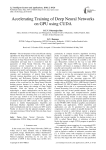
Accelerating training of deep neural networks on GPU using CUDA
Статья научная
The development of fast and efficient training algorithms for Deep Neural Networks has been a subject of interest over the past few years because the biggest drawback of Deep Neural Networks is enormous cost in computation and large time is consumed to train the parameters of Deep Neural Networks. This aspect motivated several researchers to focus on recent advancements of hardware architectures and parallel programming models and paradigms for accelerating the training of Deep Neural Networks. We revisited the concepts and mechanisms of typical Deep Neural Network training algorithms such as Backpropagation Algorithm and Boltzmann Machine Algorithm and observed that the matrix multiplication constitutes major portion of the work-load for the Deep Neural Network training process because it is carried out for a huge number of times during the training of Deep Neural Networks. With the advent of many-core GPU technologies, a matrix multiplication can be done very efficiently in parallel and this helps a lot training a Deep Neural Network not consuming time as it used to be a few years ago. CUDA is one of the high performance parallel programming models to exploit the capabilities of modern many-core GPU systems. In this paper, we propose to modify Backpropagation Algorithm and Boltzmann Machine Algorithm with CUDA parallel matrix multiplication and test on many-core GPU system. Finally we discover that the planned strategies achieve very quick training of Deep Neural Networks than classic strategies.
Бесплатно
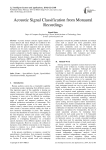
Acoustic Signal Classification from Monaural Recordings
Статья научная
Acoustic domain contains signals related to sound. Speech and music though are included in this domain, both the signals differ with various features. Features used for speech separation does not provide sufficient cue for music separation. This paper covers musical sound separation for monaural recordings. A system is proposed to classify singing voice and music from monaural recordings. For classification, time and frequency domain features along with Mel Frequency Cepstral Coefficients (MFCC) applied to input signal. Information carried by these signals permit to establish results Quantitative experimental results shows that the system performs the separation task successfully in monaural environment.
Бесплатно
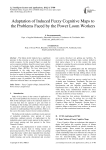
Adaptation of Induced Fuzzy Cognitive Maps to the Problems Faced by the Power Loom Workers
Статья научная
The Indian textile industry has a significant presence in the economy as well as in the international textile economy. In this research Paper we study the socio economic problems faced by power loom workers in Avinashi in Tamilnadu, India, using Induced Fuzzy Cognitive Maps (IFCMs). We have interviewed 50 households in the study area using a linguistic questionnaire. As the problems faced by them at large, involved so much of feelings and uncertainties. We felt it to fit to use fuzzy theory in general and induced fuzzy cognitive maps in particular. For IFCMs is the best suited tool when the data is an unsupervised one.
Бесплатно
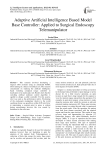
Статья научная
This research involved developing a surgical robot assistant using an articulated PUMA robot running on a linear or nonlinear axis. The research concentrated on studying the artificial intelligence based switching computed torque controller to localization of an endoscopic tool. Results show that the switching artificial nonlinear control algorithm is capable to design a stable controller. For this system, error was used as the performance metric. Positioning of the endoscopic manipulator relative to the world coordinate frame was possible to within 0.05 inch. Error in maintaining a constant point in space is evident during repositioning however this was caused by limitations in the robot arm.
Бесплатно
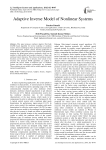
Adaptive Inverse Model of Nonlinear Systems
Статья научная
This paper proposes nonlinear adaptive filter-bank (NAFB) based algorithm for inverse modeling of nonlinear systems. Inverse modeling has been an important component for sensor linearization, adaptive control, channel equalization in communication system and active noise control. Under practical situations, the plant/system behaves nonlinearly which can be modeled as both parallel and cascaded structures of linear and nonlinear transfer functions. These linear and nonlinear transfer functions can be either static or dynamic, time variant or time invariant. The proposed NAFB algorithms are applied to generate the inverse model of different types of nonlinear systems and their convergence performances are evaluated. These nonlinear inverse models can be suitably applied to many engineering applications.
Бесплатно
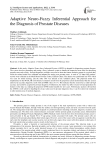
Adaptive Neuro-Fuzzy Inferential Approach for the Diagnosis of Prostate Diseases
Статья научная
In this study, Adaptive Neuro-fuzzy Inferential System (ANFIS) is adapted for diagnosing prostate diseases. The system involves generating and tuning a fuzzy inference system to handle the imprecise terms used for describing prostate cases and severity. Several diagnostic variables were used to learn the feature statistics present in a typical data, while the trained model was validated and adapted for testing new prostate cases. A total of 335 data from patients’ records were collected at the Medi Moses Prostate Centre, Kumasi Ghana. The dataset was partitioned into 70% which was used for model training, and the other 30% was utilized in the validation phase. The proposed model was implemented in the MATLAB environment. Evaluation result from the proposed system demonstrated that the system achieved an accurate diagnostic result with an RMSE value of 11%. This indicates that the system has a relatively high accuracy and could be accepted for prostate diagnosis. Furthermore, the model was able to learn well and generalize the features in the data set, making the proposed ANFIS model suitable for new cases. Performance analysis showed that the ANFIS is well suited for handling the crispy values used in prostate diagnosis; thus, it can be extensively employed in other similar areas of medical diagnosis.
Бесплатно

